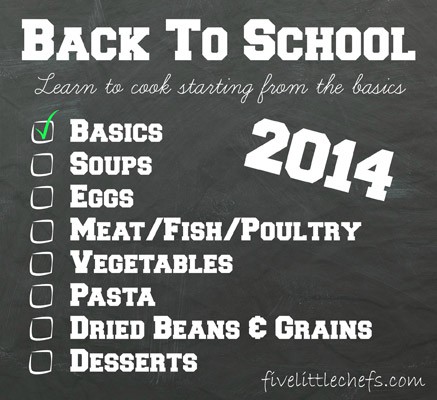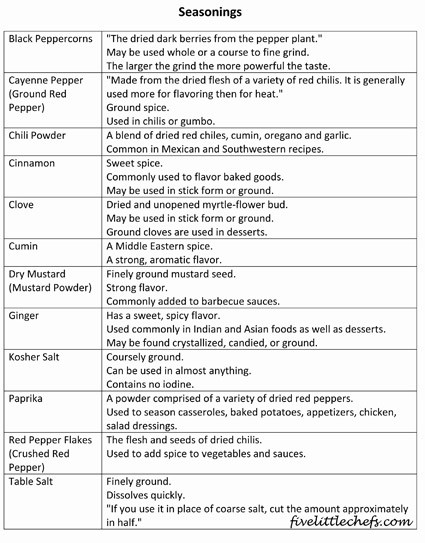Seasonings are spices kept in your pantry. It is recommended to replace all your spices each year or two. The strength of the spice diminishes as time goes by. My reality is I buy new ones as I run out. I do not label mine when I open them. (Though that is a great idea to keep track of the time it has been in your pantry.) If the flavor doesn’t come through I add more. I should throw out and replace, but I have a hard time wasting food or money.
| Black Peppercorns | “The dried dark berries from the pepper plant.”May be used whole or a course to fine grind.The larger the grind the more powerful the taste. |
| Cayenne Pepper(Ground Red Pepper) | “Made from the dried flesh of a variety of red chilis. It is generally used more for flavoring then for heat.”Ground spice.Used in chilis or gumbo. |
| Chili Powder | A blend of dried red chiles, cumin, oregano and garlic.Common in Mexican and Southwestern recipes. |
| Cinnamon | Sweet spice.Commonly used to flavor baked goods.May be used in stick form or ground. |
| Clove | Dried and unopened myrtle-flower bud.May be used in stick form or ground.Ground cloves are used in desserts. |
| Cumin | A Middle Eastern spice.A strong, aromatic flavor. |
| Dry Mustard(Mustard Powder) | Finely ground mustard seed.Strong flavor.Commonly added to barbecue sauces. |
| Ginger | Has a sweet, spicy flavor.Used commonly in Indian and Asian foods as well as desserts.May be found crystallized, candied, or ground. |
| Kosher Salt | Coursely ground.Can be used in almost anything.Contains no iodine. |
| Paprika | A powder comprised of a variety of dried red peppers.Used to season casseroles, baked potatoes, appetizers, chicken, salad dressings. |
| Red Pepper Flakes(Crushed Red Pepper) | The flesh and seeds of dried chilis.Used to add spice to vegetables and sauces. |
| Table Salt | Finely ground.Dissolves quickly.”If you use it in place of coarse salt, cut the amount approximately in half.” |
To learn even more about Seasoning read pages 24-27 in the Martha Stewart’s Cooking School Cookbook.
Assignment:
- Print the review sheet. Cut along the lines. Match the seasoning to the description. Check your work.
- Print and take the review quiz. The answers are at the bottom of the sheet so fold it over once you print.
- Go to your kitchen and find these seasonings. Smell them and take a LITTLE taste to become more familiar with them.
Extra Knowledge: When spices are heated directly in oil at the beginning of the cooking process (while you saute, say, onion and garlic), they “bloom” becoming toasty and richer tasting. If you wait to add the spices until just before your dish is done, they won’t release their powerful flavors. Your food will be bland or bitter, rather than full of fire. (Real Simple, January 2013)
Fun Fact: The original edition of Fannie Farmer’s cookbook had an ad for King Arthur Flour. Did you know King Arthur Flour still exists today? We enjoy a lot of the items they sell today!



4 Replies to "Seasonings"
hezzid January 20, 2014 (3:57 pm)
Like you, I only replace my spices whenever they are empty. Love your fact sheet! Visiting from the SITS tribe.
Kimberly FiveLittleChefs January 20, 2014 (8:40 pm)
I’m glad I’m not the only one! Thanks for stopping by.
sheriannricherson January 20, 2014 (9:16 pm)
I use a lot of herbs and spices, but I grow my own. I replace them once a year and use the old ones in the chicken coop. If I have to buy something, I try to buy it whole and use a spice crusher to crush it myself. This gives you a much better taste. I’m Sheri, btw, swinging by from the SITS Girls Tribe.
Kimberly FiveLittleChefs January 20, 2014 (9:52 pm)
We try to grow our own herbs. Sometimes we are more successful then others. One day we will learn how to grow them all well at the same time and I will have my own fresh herbs whenever I need them. I do prefer fresh and do notice a big difference in the taste. It always baffles me why fresh herbs are so expensive. They can be almost the same price as dried in a bottle.